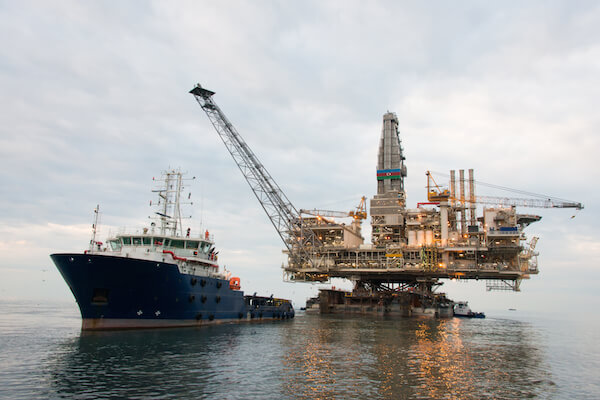Oil bulls could end up road kill following the Brexit ballot.
Crude tumbled as much as 6.8 percent June 24 after U.K. voters decided to leave the European Union. While some analysts said supply and demand still favor rising prices, Britain’s exit means there’ll be a period of uncertainty over Europe’s future, casting a shadow over the market.
“A vote for Brexit is a vote against globalization, against the free mobility of people and goods,” said Francisco Blanch, head of commodities research at Bank of America Merrill Lynch in New York. “Any reversal in the growth of trade and mobility is bad for the commodities, except gold.”
Global equities plunged after the decision, while haven assets such as the dollar and gold surged. UBS AG said traders will soon focus again on the fundamentals of the market as a global crude surplus fades. They’ll also have to weigh any lasting impact from the U.K.’s decision on the world economy and oil demand.
Money managers were bullish in the run-up to the British vote, boosting bets on rising crude prices in the week ended June 21, according to data from the Commodity Futures Trading Commission. West Texas Intermediate rose 0.7 percent to $48.85 a barrel on the New York Mercantile Exchange in the report week. Futures tumbled 4.9 percent on June 24 and were down 2.4 percent to $46.51 at 11:09 a.m.
“We were calling for $44 oil in 2016 on average, now we expect it in the low $40s, roughly $41,” said Michael D. Cohen, an analyst at Barclays Plc in New York. “The 2017 forecast has been reduced by $3, from $60 to $57.”
The surprise Brexit outcome moved the greenback, with the Bloomberg Dollar Spot Index climbing 1.8 percent on June 24, the biggest gain since October 2011. A rising U.S. currency curbs investor appetite for dollar-denominated commodities. Bookmakers’ odds suggested the chance of a vote to leave the EU was less than one in four.
Crude in New York had been on a bull run, climbing more than 80 percent from a 12-year low in February through early June as disruptions from Canada to Nigeria and falling U.S. production eased a surplus. Prices then dropped in three of the last four weeks as Canadian output rose after wildfires that disrupted production were extinguished and the U.S. rig count began to increase.
Re-Balancing Market
“There needs to be a fundamental re-balancing to the market to see sentiment turn bullish and that’s looking unlikely,” said Rob Haworth, a senior investment strategist in Seattle at U.S. Bank Wealth Management, which oversees $133 billion of assets. “The upside for oil was already limited given the rising rig count,” as well as “the fact that a number of OPEC countries plan to boost oil output,” he said.
The Organization of Petroleum Exporting Countries maintained its policy of unrestricted production at its June 2 meeting, and Iran has rejected any cap on output as it restores volumes following the removal of sanctions in January.
Not all analysts are forecasting that the Brexit vote will be bearish for oil. The period of up to two years for negotiations leading to a U.K. exit and the small relative size of the British market may act as a buffer for crude.
“Any impact on the global economy should be limited,” said Michael Wittner, the New York-based head of oil-market research at Societe Generale SA. “The biggest impact will be on the U.K. itself.”
Bullish Bets
Hedge funds’ net-long position in WTI rose by 21,586 futures and options combined to 213,075, the first gain in five weeks, CFTC data showed. Longs, or bets on rising prices, increased by 4 percent, while shorts dropped 10 percent.
In the Brent market, money managers reduced bullish bets by 9,153 contracts in the week, according to data from ICE Futures Europe. Bets that prices will rise outnumbered short positions by 362,765 lots, the London-based exchange said in a report.
In other markets, net bullish wagers on U.S. ultra low sulfur diesel rose 2.9 percent to 16,528 contracts, the highest since July 2014, as futures climbed 1 percent. Net bullish bets on Nymex gasoline surged 88 percent to 7,012 contracts, the biggest percentage gain since November. Gasoline futures increased 4.7 percent.
Precious metals were the only commodities to rise after the vote as investors flocked to havens. Gold surged 4.6 percent, its biggest one-day gain since September, while the Bloomberg Commodities Index of 22 raw materials fell 1.6 percent.
“We all got it wrong,” said Michael Lynch, president of Strategic Energy & Economic Research in Winchester, Massachusetts. “This is strengthening the dollar, which is bad for commodities.”

Russia’s giant Vankor oilfield, where Indian state oil firms are acquiring a significant stake, has reached peak production level, but technology to increase oil recovery will optimise the output and delay its decline, the head of ONGC’s overseas arm said.
Indian state firms hope to get 10.5 million tonne of crude oil from Vankor once deals are completed to acquire 49.9 % in Russia’s second-largest oilfield, whose output of 21million tonne a year is about the same as ONGC’s entire production from all its Indian fields. Rosneft had announced in March last year that Vankor’s output would decline slightly from the plateau level of 22 million tonne a year.
“We had entered at the peak production level, and as it happens in all oil fields, this field too will undergo a decline. But with the application of enhanced oil recovery techniques, the decline can be delayed and production optimised,”
ONGC announced a deal to buy 15% stake in the Vankor last year, and is in talks to raise that to 26%. This month, a consortium of Indian Oil Corporation, Oil India and Bharat Petroleum struck a deal to acquire 23.9% in Vankor. Official sources said ONGC paid $1.27 billion, while the consortium spent $2 billion for the bigger stake, giving the same valuation to the giant field.
Last week, Rosneft said the “achieved evaluation” of the Vankor project was $3.3 per barrel of reserves. Recoverable reserves of Vankor, the largest field commissioned in Russia in the last 25 years, stood at 361 million tonne of oil and condensate and 138 bcm of gas as of January this year.
India and Russia have intensified energy engagement over the past year.

The National Hydrocarbons Commission (“CNH”) submitted a draft of the Guidelines for Drilling Wells for Exploration and Production of Hydrocarbons (“Lineamientos de Perforación de Pozos para las Actividades de Exploración y Extracción”; the “Guidelines”) to the Federal Commission for Regulatory Improvement (“COFEMER”).
The Guidelines regulate well permitting, design, construction, integrity, maintenance, and abandonment standards and requirements for all oil, gas, and injection wells in Mexico, whether on-shore or off-shore, conventional or non-conventional, and which apply to both private industry and state productive companies. They regulate best oil field practices and standards for various activities; provide for inspection, audit, and enforcement; and, include provisions on operator and non-operator liability. Operators and non-operators are liable for all damages related to their activities (well drilling, design, construction, completion, and abandonment, etc.), regardless of whether their underlying exploration contracts with CNH or “entitlements” are in effect.
The Guidelines include the following attachments:
-
Glossary of defined terms.
-
Regulatory requirements on best practices for the design, construction, termination, integrity, maintenance, and abandonment of wells. These requirements are considered to be hierarchically one step below official Mexican standards (NOMs), which means that the latter have control over CNH’s referenced regulatory requirements.
-
Guidelines for registering oil and gas wells and reservoirs/fields.
-
Guidelines for well-permitting applications.
-
Guidelines for ensuring well integrity (e.g., casing and cementing requirements and standards).
-
Format to request administrative registration of wells.
-
Format to apply for drilling and completion well permits.
-
Format for applications to modify previously granted well permits.

Rebounding after a two-year collapse, it’s only this month that oil prices have pushed up past $50 a barrel, but Raymond James & Associates says this is just the beginning for higher prices.
In a note to clients, analysts led by J. Marshall Adkins say West Texas Intermediate will average $80 per barrel by the end of next year — that’s higher than all but one of the 31 analysts surveyed by Bloomberg.
“Over the past few months, we’ve gained even more confidence that tightening global oil supply/demand dynamics will support a much higher level of oil prices in 2017,” the team says. “We continue to believe that 2017 WTI oil prices will average about $30/barrel higher than current futures strip prices would indicate.”
The team went on to lay out three reasons for their bullish call, all of which are tied to global supply — the primary factor that precipitated crude’s massive decline.
Here’s how the rebalancing of the global oil market will be expedited from the supply side, according to the analysts:
First, the analysts see production outside the U.S. being curbed by more than they had previously anticipated, which constitutes 400,000 fewer barrels of oil per day being produced in 2017 relative to their January estimate. In particular, they cite organic declines in China, Columbia, Angola, and Mexico as prompting this downward revision.
“When oil drilling activity collapses, oil supply goes down too!,” writes Raymond James. “Amazing, huh?”
Adkins and his fellow analysts also note that the unusually large slew of unplanned supply outages will, in some cases, persist throughout 2017, taking a further 300,000 barrels per day out of global supply.
Finally, U.S. shale producers won’t be able to get their DUCs in a row to respond to higher prices by ramping up output, the team reasons, citing bottlenecks that include a limited available pool of labor and equipment.
Combine this supply curtailment with firmer than expected global demand tied to gasoline consumption, and Adkins has a recipe for $80 crude in relatively short order.
“These newer oil supply/demand estimates are meaningfully more bullish than at the beginning of the year,” he writes. “Our previous price forecast was considerably more bullish than current Street consensus, and our new forecast is even more so.”
The only analyst with a higher price forecast for 2017, among those surveyed by Bloomberg, is Incrementum AG Partner Ronald Stoeferle. He sees West Texas Intermediate at $82 per barrel next year. The consensus estimate is for this grade of crude to average $54 per barrel in 2017.
Over the long haul, however, Raymond James’ team sees WTI prices moderating to about $70 per barrel.

The next bidding round in the opening of Mexico’s oil and gas sector will be called by the end of July and consist of 15 shallow water blocks for exploration and extraction in the Gulf of Mexico, Energy Minister Pedro Joaquin Coldwell said.
Coldwell announced the round, denominated 2.1, at an event in the northern city of Monterrey on Wednesday.
The following round, or 2.2, would be called by the end of the summer and comprise 14 onshore blocks for exploration and production in the gas-rich Burgos basin in the north of the country as well as in southeast Mexico, Coldwell added.
Mexico ended the oil and gas monopoly of national oil company Pemex at the end of 2013 to open up the industry to more private sector investment. However, the auctions of oil and gas blocks have been complicated by a sharp drop in crude prices.
Crude futures on Wednesday hit their highest levels in 2016, beyond $50 per barrel. Coldwell said it was very hard to forecast whether the recovery in prices would last

Mexican state oil company Pemex has picked the deep-water Trion field near the U.S. border as the first one it will farm out to other operators to help it develop untapped resources, the firm said on Friday.
The search for private capital to boost areas previously discovered by Pemex is a major step in the opening up of Mexico’s oil and gas industry, a process enabled by an energy reform that ended the company’s monopoly in 2013.
Pemex Chief Executive Jose Antonio Gonzalez Anaya told a news conference the company’s board had approved the step and that Trion would likely be operated by a company other than Pemex.
“It’s a big, important field,” Gonzalez said.
The Trion field, located in the Perdido area, will require about $11 billion worth of investment and more farm outs will follow, Gonzalez said. In total, the Trion field contained some 480 million barrels, he added.
Pemex did not have a specific number of investors in mind for the Trion field, he said. The companies involved in the farm out should be announced in December, when Mexico has scheduled its first auctions for deep water fields.
Speaking at the same news conference, Energy Minister Pedro Joaquin Coldwell said the Trion farm out would be in the form of a license and that the field was 2,500 meters (8,202 feet) deep.
Two years of falling crude prices have hurt Pemex, which wants partners to boost output and improve margins.
In the first quarter of this year, Pemex ran up its 14th consecutive quarterly loss at about 62 billion pesos ($3.6 billion), as both crude prices and output fell.
Earlier, Pemex announced that Luis Rafael Montanaro Sanchez had been named as the new director of Pemex’s ethylene unit.

Global oil demand could peak by the end of the next decade even as global economic growth climbs.
The latest downward revision to forecasts, from consulting firm McKinsey, could leave major new investments uneconomic if demand for energy fails to meet expectations.
McKinsey said it has cut its forecast for growth in demand to 0.8pc a year to 2040, “well below mainstream base case perspectives”, including its own estimate of 1.1pc made last year.
Demand for oil is expected to grow even more slowly beyond 2025, with the research pointing to a possible peak of 100m barrels a day by 2030, from current levels of 94m.
The industry is mired in debt after the plunge in oil prices in recent years.
McKinsey’s Occo Roelofsen said despite an expected increase in global population of around 36pc, and a doubling in global gross domestic product (GDP), shifting energy sector dynamics are set to depress energy demand.
“ This change is driven by three factors: first, overall GDP growth is structurally lower as the population ages; second, the global economy is shifting away from energy-intense industry towards services; and third, energy efficiency continues to improve significantly,” he said. “Peak oil demand could be reached around 2030. ”
Meanwhile growth in electricity demand will outstrip other sources of energy by more than two to one, due to the steady “electrification” of building and industry in China and India.
Almost 80pc of the capacity needed to meet this increase will be from solar and wind power, McKinsey predicts.

Jim Dehlsen, a 79-year-old wind-energy pioneer who sold one turbine company to Enron and took another public, has spent his life thinking about the best way to make blades turn in the sky. For his latest effort, he’s flipping a turbine upside down and plunging it dozens of meters into the ocean, in waters that are up to 300 meters deep. There, marine currents rotate the 13.5-meter long blades to pull power from the sea.
Aquantis, Dehlsen’s Santa Barbara, Calif., company, will start deploying turbines in 2018 in waters near Wales and the Isle of Wight. Its most ambitious project is a 200-megawatt field of marine turbines in the strong Gulf Stream off the coast of Florida, due to come online in 2019 or 2020. The world’s oceans remain relatively untapped as an energy source, compared with wind and solar. By 2030, Dehlsen says, marine energy could serve 8 percent or 9 percent of U.S. power needs. “The oceans are the major remaining potential for renewable energy,” he says. “Getting on that now is really urgent.”
It took wind at least 15 years to become a viable, cost-effective resource. In the late 1970s, when scientists first started experimenting with wind turbines, “people laughed at you and said, ‘Wind will never work,’ ” says Robert Thresher, a research fellow at the National Renewable Energy Laboratory in Golden, Colo. In the ’80s and ’90s, the industry settled on the three-blade turbine design considered the standard today. Many aspects of turbine design can be applied to the oceans, adjusted to handle the slower, heftier fluid dynamics of seawater.
Aquantis is developing systems to capture energy from waves, from tidal currents, which switch direction twice a day, and from gyre, or steady, currents. Much of Dehlsen’s obsession these days is with the Gulf Stream. Its constant current can rotate turbines day and night, allowing Aquantis to squeeze more power out of each turbine. That will cut the price per kilowatt-hour. “Because the stream flows all the time, it’s probably the one that can become cost-effective most easily,” Thresher says.
Aquantis, which isn’t the first company to design underwater turbines, wants to lower the cost of marine energy. Dehlsen says deploying an Aquantis device—towing it out to sea, filling it with seawater ballast, then anchoring it—runs about $347,000 per turbine. The rotor’s two blades can withstand huge volumes of water moving as fast as 4 knots. The topmost part floats just above the surface, and the rest of the equipment is held in place with mooring lines to the ocean floor, making it quicker to deploy and cheaper to maintain. Repair crews take an elevator down the shaft. Rival turbine makers dig deep into the ocean floor to anchor the machinery so that it can withstand the strength of the currents; their repairs require raising the structure to the surface. That pushes up the cost significantly, Dehlsen says, to about five to seven times more than Aquantis’s.
Dehlsen plans to install his turbines in a few test sites and sell power to the grid. He sees a second revenue stream in marine turbines housing data centers for the world’s tech giants, using the turbine’s shaft as a storage area for racks of servers. That can save companies money on air conditioning by using cold ocean water to cool the equipment. Aquantis designed and built a pilot test chamber for Microsoft that housed a data center underwater for 105 days off California’s San Luis Obispo pier last year. The test was a success, Microsoft said, with minimal ocean heating and no leaks or hardware failures. Dehlsen is reaching out to Apple, Facebook, and Google about similar efforts.
Dehlsen is courting tech companies and investors while trying to lock down test sites from the north coast of Brazil to Cape Agulhas, on the southern tip of Africa. Little testing has taken place in the U.S. Aquantis has won Department of Energy grants and received some venture capital from Mistubishi Heavy Industries. Dehlsen has self-funded a lot of the work; additional income comes from projects like the data center program. His track record in renewable energy reassures potential partners, says Charles Vinick, Aquantis’s chief executive officer. “Jim is seen as the father of American wind—that opens the door.”
Marine turbines face some challenges, such as concerns over unknown environmental effects. Their blades could strike whales or create noise that confuses sea life. Dehlsen says studies conducted in the U.K. show turbines are safe for fish and marine life. The bigger challenge, he says, is creating marine energy that is cost-competitive. He expects to get to less than 10¢ a kilowatt-hour in three to five years. (Wind energy hovers from 3¢ to 8¢ a kilowatt-hour, solar from 4¢ to 7¢, and conventional gas from 5¢ to 8¢.) “In renewable energy, people get enthusiastic about an idea, and yes, maybe you can make electricity. But if it’s 8¢ a kilowatt-hour, so what?” he says. “Don’t even bother.”
Dehlsen’s best argument may be a slide in his presentation about the urgency of global warming. “The time that’s left in which we can make a change is relatively short,” he says. “Five to 10 years, and you’re beyond being able to stem it.”

Scroll to top

 Breaking Barriers and Building the Future18 March, 2025
Breaking Barriers and Building the Future18 March, 2025 Fundamental factors to strengthen Pemex12 August, 2019
Fundamental factors to strengthen Pemex12 August, 2019 Offshore Project Development: The Road to First Oil26 July, 2019
Offshore Project Development: The Road to First Oil26 July, 2019






